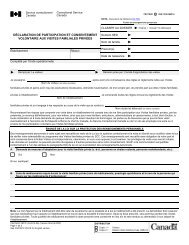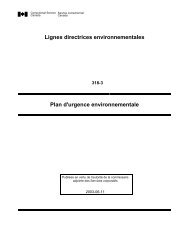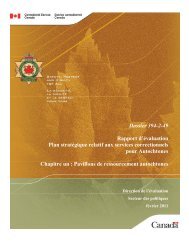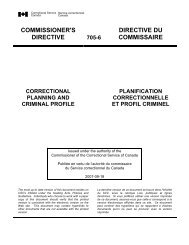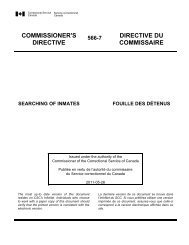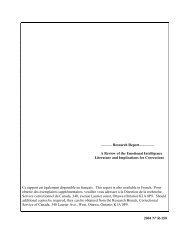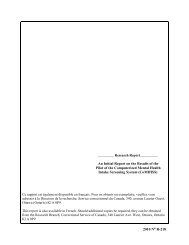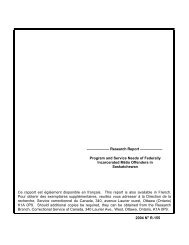Management of Halocarbons - Service correctionnel du Canada
Management of Halocarbons - Service correctionnel du Canada
Management of Halocarbons - Service correctionnel du Canada
You also want an ePaper? Increase the reach of your titles
YUMPU automatically turns print PDFs into web optimized ePapers that Google loves.
RECOVERY<br />
Correctional <strong>Service</strong><br />
<strong>Canada</strong><br />
<strong>Service</strong> <strong>correctionnel</strong><br />
<strong>Canada</strong> EG 318-4 – <strong>Management</strong> <strong>of</strong> <strong>Halocarbons</strong><br />
7. A certified person that installs, services, leak tests or charges a halocarbon to a refrigeration or an<br />
air-conditioning system, or that does any other work on any <strong>of</strong> those systems that may result in the<br />
release <strong>of</strong> a halocarbon, shall recover, into an appropriate container, any halocarbon that would<br />
otherwise be released <strong>du</strong>ring those proce<strong>du</strong>res [see sections 2.10 and 3.5 – Refrigerant Code <strong>of</strong><br />
Practice].<br />
8. Before dismantling, decommissioning or disposing <strong>of</strong> any system, a person shall:<br />
a) recover halocarbons into an appropriate container and dispose <strong>of</strong> as hazardous waste [see<br />
sections 2.9 and 3.4 to 3.8 – Refrigerant Code <strong>of</strong> Practice];<br />
b) place a notice (label) on the system containing the information set out in Sche<strong>du</strong>le 5 –<br />
Dismantling, Decommissioning or Destruction Notice for a System (note that no person shall<br />
remove this notice except to replace it with another such notice); and<br />
c) once the decommissioning is completed, ensure that the dismantled system can never be<br />
reused.<br />
9. In case <strong>of</strong> the dismantling, disposing or decommissioning <strong>of</strong> any system, a record <strong>of</strong> the information<br />
contained in this notice (label) shall be kept on site in the service log [see Sche<strong>du</strong>le 6 –<br />
Refrigeration System and Air-conditioning System <strong>Service</strong> Log].<br />
Note: At CSC, systems with a capacity over 19 kilowatts or 5.4 tons are <strong>of</strong>ten in the custody <strong>of</strong> responsibility centers like<br />
Food <strong>Service</strong>s, Corcan, and Plant Maintenance, each <strong>of</strong> which may have a contract with a different external supplier to<br />
service its machines. It is suggested that the Maintenance <strong>Management</strong> System (MMS) operated by the Chief <strong>of</strong> Plant<br />
Maintenance (CPM) be used to issue a work order to record the test results <strong>of</strong> the inspections that are required by law for<br />
each system with a capacity over 19 kilowatts or 5.4 tons, whether or not it is in CPM custody. Additionally, it is<br />
suggested that each non-CPM custodian establish a proce<strong>du</strong>re to ensure that the results <strong>of</strong> all other inspections and<br />
repairs to their systems are recorded in the MMS and in the service log.<br />
REQUIREMENTS FOR SMALL SYSTEMS<br />
10. When dismantling, disposing or decommissioning <strong>of</strong> equipment that contains a small system (i.e.<br />
with a refrigeration capacity <strong>of</strong> less than 19 kilowatts or 5.4 tons such as the one in a motor vehicle,<br />
refrigerator or water cooler), the parts <strong>of</strong> the apparatus that contain halocarbon must be<br />
decommissioned before disposal. However, when selling or transferring used equipment containing<br />
a small system that a new owner is expected to continue to operate, it is not necessary to<br />
decommission the small system unless it leaks while in CSC custody.<br />
11. Arrange for a certified person to recover the halocarbons from any small system in which a<br />
halocarbon leak has been discovered, or which is being decommissioned (dismantled or disposed).<br />
In this situation, place a notice (label) on the small system containing the information set out in<br />
Sche<strong>du</strong>le 5 (Dismantling, Decommissioning or Destruction Notice for a System). No person shall<br />
remove this notice except to replace it with another such notice. Record the information set out in<br />
Sche<strong>du</strong>le 6 (Refrigeration System and Air-conditioning System <strong>Service</strong> Log) when a small system is<br />
purged.<br />
Environmental Programs, NHQ Page 8 2005-05-04



